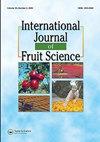Study of Various Floral Types on Different Plants of Garcinia indica (Thouars) Choisy and Correlation of Its Functionality in Sexual Reproduction
IF 2.4
3区 农林科学
Q2 HORTICULTURE
引用次数: 2
Abstract
ABSTRACT Genus Garcinia shows high diversity of sexual systems; most of them are dioecious in nature. The other reported sexual systems of Garcinia include gynodioecious, androdioecious, monoecious, and andromonoecious. Garcinia indica (Thouars) Choisy was reported as facultative apomictic polygamodioecious species. There is a large diversity in floral types. Hence, a detailed study of various floral types found on different types of plants of G. indica and to correlate its functionality with sexual reproduction was undertaken. The study at Kokum Plot, BSSKVV, Dapoli, revealed that the male plants could be categorized into four types – androecious, functional males, andromonoecious, and hermaphrodites. The female plants displayed large variation in number and viability of stamens/staminodes. Each category showed significant difference in phenology, floral morphology and pollen types. In December, the percentage of staminate flowers (79.13 ± 2.93%) in androecious trees was significantly higher than functional males (58.61 ± 8.60%) or andromonoecious trees (56.36 ± 2.77%) (p ≤ .01). As female plants started flowering, all male morphotypes bore significantly higher numbers of staminate flowers and carpellate flowers were significantly reduced. Pollen viability was highest in androecious flowers at 90.11 ± 1.10% and lowest at 64.70 ± 2.09% in hermaphrodite trees. Earlier studies reported female flowers bore well-developed female gametophyte, but the embryo development was not observed. Thus, the fruit formation might be apomictic, but in present embryological investigation; more than 60% of female and andromonoecious flowers, a well-developed embryo was formed between 8 and 24 h after anthesis. Thus, the embryo formation might be sexual or apomictic. Floral types favoring sexual reproduction are essential for conservation of highly endemic species.黄花藤黄(Garcinia indica)不同植物花型的研究及其有性生殖功能的相关性
藤黄属具有高度的性系统多样性;它们大多数是雌雄异株。其他报道的藤黄性系统包括雌蕊异株、雄蕊异株、雌雄异株和雄蕊异株。Garcinia indica (Thouars) Choisy是兼性无杂交多雌异种。花的种类有很大的多样性。因此,本文对籼稻不同类型植物的花型及其功能与有性生殖的关系进行了详细的研究。在达波利市BSSKVV的Kokum地块进行的研究表明,雄性植物可分为雄性、功能雄性、雄性雌雄同体和雌雄同体4种类型。雌株雄蕊/雄蕊数量和活力差异较大。各类群的物候、花形态和花粉类型均有显著差异。12月雄蕊树雄蕊花比例(79.13±2.93%)显著高于功能雄树(58.61±8.60%)和雄蕊树(56.36±2.77%)(p≤0.01)。雌性植株开花后,雄蕊花数量显著增加,无皮花数量显著减少。雄蕊花花粉活力最高,为90.11±1.10%,雌雄同体树花粉活力最低,为64.70±2.09%。早期的研究报道雌花具有发育良好的雌配子体,但未观察到胚胎发育。因此,果实的形成可能是无融合的,但在目前的胚胎学研究中;60%以上的雌花和雄雄花在花后8 ~ 24 h形成发育良好的胚。因此,胚胎形成可能是有性的,也可能是无分裂的。有利于有性生殖的花型对高度地方性物种的保护至关重要。
本文章由计算机程序翻译,如有差异,请以英文原文为准。
求助全文
约1分钟内获得全文
求助全文
来源期刊

International Journal of Fruit Science
Agricultural and Biological Sciences-Agronomy and Crop Science
CiteScore
6.40
自引率
0.00%
发文量
64
审稿时长
10 weeks
期刊介绍:
The International Journal of Fruit Science disseminates results of current research that are immediately applicable to the grower, extension agent, and educator in a useful, legitimate, and scientific format. The focus of the journal is on new technologies and innovative approaches to the management and marketing of all types of fruits. It provides practical and fundamental information necessary for the superior growth and quality of fruit crops.
This journal examines fruit growing from a wide range of aspects, including:
-genetics and breeding
-pruning and training
-entomology, plant pathology, and weed science
-physiology and cultural practices
-marketing and economics
-fruit production, harvesting, and postharvest
 求助内容:
求助内容: 应助结果提醒方式:
应助结果提醒方式:


